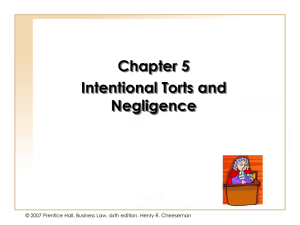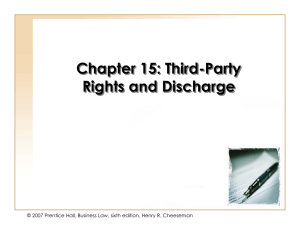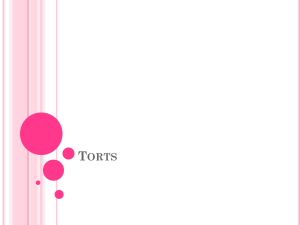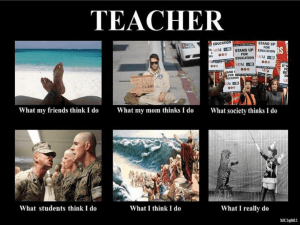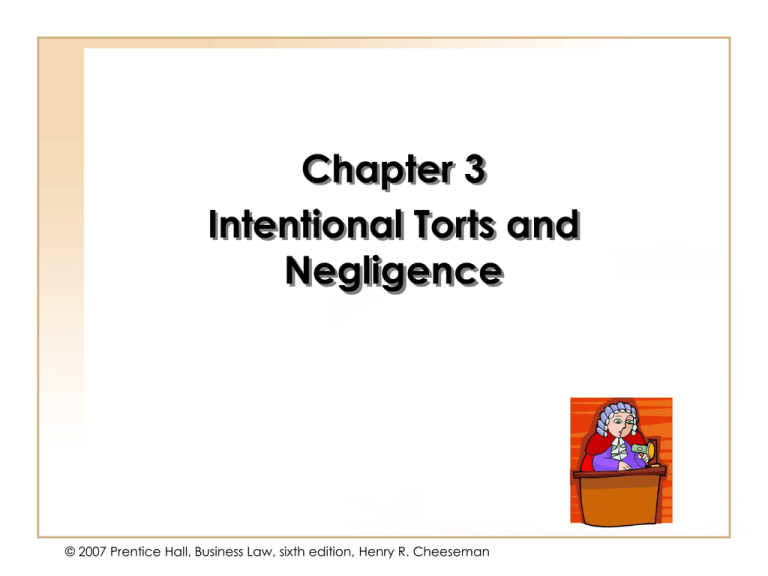
Chapter 3
Intentional Torts and
Negligence
© 2007 Prentice Hall, Business Law, sixth edition, Henry R. Cheeseman
Copyright © 2004 by Prentice-Hall. All rights reserved.
Introduction
• Tort is the French word
for a “wrong.”
• Tort law protects a
variety of injuries and
provides remedies for
them.
© 2006 Prentice Hall, Business Law, sixth edition, Henry R. Cheeseman
4-2
Introduction (continued)
• Under tort law, an
injured party can bring a
civil lawsuit to seek
compensation for a
wrong done to the party
or the party’s property.
© 2006 Prentice Hall, Business Law, sixth edition, Henry R. Cheeseman
4-3
Introduction (continued)
• Tort damages are
monetary damages that
are sought from the
offending party.
• They are intended to
compensate the injured
party for the injury
suffered.
© 2006 Prentice Hall, Business Law, sixth edition, Henry R. Cheeseman
4-4
Tort law imposes a duty on
persons and business agents
not to intentionally or
negligently injure others in
society.
© 2006 Prentice Hall, Business Law, sixth edition, Henry R. Cheeseman
4-5
Types of Torts
Intentional Torts
Unintentional Torts
(Negligence)
Strict Liability Torts
© 2006 Prentice Hall, Business Law, sixth edition, Henry R. Cheeseman
4-6
Intentional Torts Against
Persons
• The law protects a person
from unauthorized
touching, restraint, or other
contact.
• The law also protects a
person’s reputation and
privacy.
• Violations of these rights
are actionable as torts.
© 2006 Prentice Hall, Business Law, sixth edition, Henry R. Cheeseman
4-7
Intentional Torts Against Persons (continued)
• Assault
– The threat of immediate
harm or offensive contact; or
– Any action that arouses
reasonable apprehension of
imminent harm.
– Actual physical contact is
unnecessary.
© 2006 Prentice Hall, Business Law, sixth edition, Henry R. Cheeseman
4-8
Intentional Torts Against Persons (continued)
• Battery
– Unauthorized and harmful or
offensive physical contact
with another person.
– Actual physical contact is
unnecessary between victim
and perpetrator.
– May accompany assault.
© 2006 Prentice Hall, Business Law, sixth edition, Henry R. Cheeseman
4-9
Intentional Torts Against Persons (continued)
• Doctrine of Transferred
Intent
– Party A intends to harm party
B, but actually injures Party
C.
– Law transfers perpetrator’s
intent from target to actual
victim.
– Victim can then sue
perpetrator.
© 2006 Prentice Hall, Business Law, sixth edition, Henry R. Cheeseman
4 - 10
Intentional Torts Against Persons (continued)
• False Imprisonment
– The intentional confinement
or restraint of another person
without authority or
justification and without that
person’s consent.
• Physical force
• Barriers
• Threats of physical violence
• False arrest
© 2006 Prentice Hall, Business Law, sixth edition, Henry R. Cheeseman
4 - 11
Intentional Torts Against Persons (continued)
• False Imprisonment
(continued)
– Threat of future harm or
moral pressure not enough
– Must be complete
imprisonment
• Locking only one of several
doors not sufficient
© 2006 Prentice Hall, Business Law, sixth edition, Henry R. Cheeseman
4 - 12
Intentional Torts Against Persons (continued)
• False Imprisonment (continued)
– Merchant Protection Statutesmerchants may stop, detain,
and investigate suspected
shoplifters without being held
liable for false imprisonment.
• There are reasonable grounds for the
suspicion,
• Suspects are detained for only a reasonable
time, and
• Investigations are conducted in a reasonable
manner.
© 2006 Prentice Hall, Business Law, sixth edition, Henry R. Cheeseman
4 - 13
Intentional Torts Against Persons (continued)
• Misappropriation of the
Right to Publicity
– An attempt by another
person to appropriate a
living person’s name or
identity for commercial
purposes.
– Also known as the tort of
appropriation.
© 2006 Prentice Hall, Business Law, sixth edition, Henry R. Cheeseman
4 - 14
Intentional Torts Against Persons (continued)
• Invasion of the Right to
Privacy
– Tort that constitutes the
violation of a person’s right
to live his or her life without
being subjected to
unwanted and undesired
publicity.
– Placing one in a “false light”
© 2006 Prentice Hall, Business Law, sixth edition, Henry R. Cheeseman
4 - 15
Intentional Torts Against Persons (continued)
• Defamation of Character
– False statement(s) made by
one person about another.
The plaintiff must prove that:
• The defendant made an an
untrue statement of fact
about the plaintiff; and
• The statement was
intentionally or accidentally
published to a third party.
© 2006 Prentice Hall, Business Law, sixth edition, Henry R. Cheeseman
4 - 16
Intentional Torts Against Persons (continued)
• Defamation of Character
(continued)
– Slander – oral defamation of
character.
– Libel – a false statement that
appears in a letter,
newspaper, magazine,
book, photo, video, etc.
© 2006 Prentice Hall, Business Law, sixth edition, Henry R. Cheeseman
4 - 17
Intentional Torts Against Persons (continued)
• Defamation of Character
(continued)
• In New York Times v. Sullivan,
the U.S. Supreme Court held
that public officials cannot
recover for defamation unless
they can prove that the
defendant acted with actual
malice.
© 2006 Prentice Hall, Business Law, sixth edition, Henry R. Cheeseman
4 - 18
Intentional Torts Against Persons (continued)
• Disparagement
– Untrue statement made
about products, services,
property, or reputation of a
business
– Also called product
disparagement, trade libel,
or slander of title
© 2006 Prentice Hall, Business Law, sixth edition, Henry R. Cheeseman
4 - 19
Intentional Torts Against Persons (continued)
• Intentional
Misrepresentation (Fraud)
– Wrongdoer deceives
another person out of
money, property, or
something of value.
– Injured party can recover
damages.
© 2006 Prentice Hall, Business Law, sixth edition, Henry R. Cheeseman
4 - 20
Intentional Torts Against Persons (continued)
• Intentional
Misrepresentation (Fraud)
– Elements:
• Wrongdoer made a false
representation
• Wrongdoer knew
representation was false and
intended to deceive other
party
• Party must justifiably rely on
misrepresentation
• Must have actual injury
© 2006 Prentice Hall, Business Law, sixth edition, Henry R. Cheeseman
4 - 21
Intentional Torts Against Persons (continued)
• Intentional Infliction of
Emotional Distress
– Tort that says a person whose
extreme and outrageous
conduct intentionally or
recklessly causes severe
emotional distress to another
person is liable for that
emotional distress.
– Also known as the tort of
outrage.
© 2006 Prentice Hall, Business Law, sixth edition, Henry R. Cheeseman
4 - 22
Intentional Torts Against Persons (continued)
• Malicious Prosecution
– Losing plaintiffs that have
brought a frivolous lawsuit
may be sued by the
prevailing defendant
– Civil action for damages
– Must have suffered injury
© 2006 Prentice Hall, Business Law, sixth edition, Henry R. Cheeseman
4 - 23
Intentional Torts Against
Property
• There are two general
categories of property:
– Real Property
• land and anything permanently
attached to that land.
– Personal Property
• things that are movable.
–
–
–
–
Automobiles
Books
Clothes
Pets
© 2006 Prentice Hall, Business Law, sixth edition, Henry R. Cheeseman
4 - 24
Intentional Torts Against Property (continued)
• Trespass to Land
– A tort that interferes with an
owner’s right to exclusive
possession of land.
– Unauthorized use of another
person’s property
© 2006 Prentice Hall, Business Law, sixth edition, Henry R. Cheeseman
4 - 25
Intentional Torts Against Property (continued)
• Trespass to and
Conversion of Personal
Property
– Tort of trespass occurs:
• Whenever one person injures
another person’s personal
property
• When one interferes with a
person’s enjoyment of his or her
personal property.
© 2006 Prentice Hall, Business Law, sixth edition, Henry R. Cheeseman
4 - 26
Intentional Torts Against Property (continued)
• Trespass to and
Conversion of Personal
Property
– A tort that deprives a true
owner of the use and
enjoyment of his or her
personal property by:
• Taking over such property;
and
• Exercising ownership rights
over it.
© 2006 Prentice Hall, Business Law, sixth edition, Henry R. Cheeseman
4 - 27
Unintentional Torts (Negligence)
• Unintentional Tort
– A doctrine that says a person
is liable for harm that is the
foreseeable consequence of
his or her actions.
© 2006 Prentice Hall, Business Law, sixth edition, Henry R. Cheeseman
4 - 28
Unintentional Torts (Negligence)
(continued)
• Negligence
– Negligence is the omission to
do something which a
reasonable man would do,
or something which a
prudent and reasonable
man would not do.
© 2006 Prentice Hall, Business Law, sixth edition, Henry R. Cheeseman
4 - 29
Unintentional Torts (Negligence)
(continued)
To be successful in a
negligence lawsuit, the
plaintiff must prove that:
1. The defendant owed a
duty of care to the plaintiff
2. The defendant breached
the duty of care
3. The plaintiff suffered injury
4. The defendant’s negligent
act caused the plaintiff’s
injury
© 2006 Prentice Hall, Business Law, sixth edition, Henry R. Cheeseman
4 - 30
Unintentional Torts (Negligence)
(continued)
• Duty of Care
– the obligation we all each
other not to cause any
unreasonable harm or risk of
harm.
– The courts apply a
reasonable person standard.
– Defendants with a particular
expertise or competence
are measured against a
reasonable professional
standard.
© 2006 Prentice Hall, Business Law, sixth edition, Henry R. Cheeseman
4 - 31
Unintentional Torts (Negligence)
(continued)
• Breach of Duty – a failure
to exercise care or to act
as a reasonable person
would act.
© 2006 Prentice Hall, Business Law, sixth edition, Henry R. Cheeseman
4 - 32
Unintentional Torts (Negligence)
(continued)
• Causation – a person who
commits a negligent act is
not liable unless his or her
act was the cause of the
plaintiff’s injuries.
– Causation in Fact (actual
cause)
– Proximate Cause (legal
cause)
© 2006 Prentice Hall, Business Law, sixth edition, Henry R. Cheeseman
4 - 33
Unintentional Torts (Negligence)
(continued)
• Injury to Plaintiff
– the plaintiff must suffer
personal injury or damage to
his or her property to recover
monetary damages for the
defendant’s negligence.
© 2006 Prentice Hall, Business Law, sixth edition, Henry R. Cheeseman
4 - 34
Unintentional Torts (Negligence)
(continued)
• Actual Cause
– Defendant’s negligent act
must be causation in fact
– The actual cause of
negligence.
– Must have cause-and effect
relationship
© 2006 Prentice Hall, Business Law, sixth edition, Henry R. Cheeseman
4 - 35
Special Negligence Doctrines
(continued)
• Proximate Cause
– Under the law, a negligent party is
not necessarily liable for all
damages set in motion by his or
her negligent act.
– The law establishes a point along
the damage chain after which the
negligent party is no longer legally
responsible for the consequences
of his or her actions.
– General test is forseeability
© 2006 Prentice Hall, Business Law, sixth edition, Henry R. Cheeseman
4 - 36
Special Negligence Doctrines
(continued)
• Professional Malpractice
– The liability of a professional
who breaches his or her duty
of ordinary care.
– Reasonable professional
standard
• Medical malpractice
• Legal malpractice
• Accounting malpractice
© 2006 Prentice Hall, Business Law, sixth edition, Henry R. Cheeseman
4 - 37
Special Negligence Doctrines
(continued)
• Negligent Infliction of
Emotional Distress
– A tort that permits a person
to recover for emotional
distress caused by the
defendant’s negligent
conduct.
– Some states require physical
manifestation
© 2006 Prentice Hall, Business Law, sixth edition, Henry R. Cheeseman
4 - 38
Special Negligence Doctrines
(continued)
• Negligence Per
Se
• Res Ipsa Loquitur
• Good Samaritan
Laws
• Dram Shop Acts
• Guest Statutes
• Fireman’s Rule
• “Danger Invites
Rescue” Doctrine
• Social Host
Liability
• Liability of
Landowners
• Liability of
Common
Carriers and
Innkeepers
© 2006 Prentice Hall, Business Law, sixth edition, Henry R. Cheeseman
4 - 39
Special Negligence Doctrines
(continued)
• Negligence Per Se
– Violation of a statute that
proximately causes an injury
– Plaintiff must be within class
intended to be protected
– Statute enacted to prevent
the type of injury suffered
© 2006 Prentice Hall, Business Law, sixth edition, Henry R. Cheeseman
4 - 40
Special Negligence Doctrines
(continued)
• Res Ipsa Loquitur
– “The thing speaks for itself”
– Defendant had exclusive
control of situation that
caused plaintiff’s injury
– Injury would not have
ordinarily occurred but for
someone’s negligence
© 2006 Prentice Hall, Business Law, sixth edition, Henry R. Cheeseman
4 - 41
Special Negligence Doctrines
(continued)
• Good Samaritan Laws
– Protects medical
professionals that stop and
render emergency first aid
– Relieves them from liability
for ordinary negligence
– No relief for gross negligence
or intentional or reckless
conduct
– Laypersons not trained in
CPR not covered
© 2006 Prentice Hall, Business Law, sixth edition, Henry R. Cheeseman
4 - 42
Special Negligence Doctrines
(continued)
• Dram Shop Acts
– Taverns and bartenders can
be held civilly liable for
injuries caused to or by
patrons who were served too
much alcohol.
© 2006 Prentice Hall, Business Law, sixth edition, Henry R. Cheeseman
4 - 43
Special Negligence Doctrines
(continued)
• Guest Statutes
– Driver voluntarily gives ride to
another
– No compensation paid
– Driver not held liable for
injuries caused by driver’s
ordinary negligence
– Driver still liable for gross
negligence
© 2006 Prentice Hall, Business Law, sixth edition, Henry R. Cheeseman
4 - 44
Special Negligence Doctrines
(continued)
• Fireman’s Rule
– Firefighters cannot sue
negligent party for injuries
incurred putting out fires
– Applies to police and
government workers
– Specially trained to do their
jobs
– They have special medical
and retirement programs
paid for by public
© 2006 Prentice Hall, Business Law, sixth edition, Henry R. Cheeseman
4 - 45
Special Negligence Doctrines
(continued)
• “Danger Invites Rescue”
Doctrine
– Persons who are injured
going to the rescue of
another can sue the person
who caused the dangerous
situation
© 2006 Prentice Hall, Business Law, sixth edition, Henry R. Cheeseman
4 - 46
Special Negligence Doctrines
(continued)
• Social Host Liability
– Social host liable for injuries
caused by guests who are
served alcohol at a social
function
– injure themselves or another
due to intoxication
© 2006 Prentice Hall, Business Law, sixth edition, Henry R. Cheeseman
4 - 47
Special Negligence Doctrines
(continued)
• Liability of Landowners
– Duty of ordinary care owed
to invitees and licensees
• Invitees on premises for mutual
benefit of both parties with
consent
• Licensee on premises for own
benefit, but with consent
– Duty not to willfully or
wantonly injure trespassers
• Person has no invitation or right
to be on property
© 2006 Prentice Hall, Business Law, sixth edition, Henry R. Cheeseman
4 - 48
Special Negligence Doctrines
(continued)
• Liability of Common
Carriers and Innkeepers
– Duty of utmost care to
passengers and guests
© 2006 Prentice Hall, Business Law, sixth edition, Henry R. Cheeseman
4 - 49
Superseding or
Assumption of
Intervening
the Risk
Event
DEFENSES
AGAINST
NEGLIGENCE
Contributory
Comparative
Negligence
Negligence
© 2006 Prentice Hall, Business Law, sixth edition, Henry R. Cheeseman
4 - 50
Strict Liability
• Strict liability is liability
without fault.
• A participant in a covered
activity will be held liable
for any injuries caused by
the activity even if he or
she was not negligent.
© 2006 Prentice Hall, Business Law, sixth edition, Henry R. Cheeseman
4 - 51
Strict Liability (continued)
This doctrine holds that:
1.
There are certain activities
that can place the public
at risk of injury even if
reasonable care is taken;
and
2.
The public should have
some means of
compensation if such injury
occurs.
© 2006 Prentice Hall, Business Law, sixth edition, Henry R. Cheeseman
4 - 52

